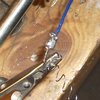And Cadmium grows whiskers, which are conductive,and can be a problem. We have had problems with wavechange switches in the vintage AM radios. The shaft through the centre of the wafers of the switch is cadmium plated and grows whiskers which grow all the way across to the moving contacts and short circuit them to ground. We're not talking LEAKAGE, we're talking DEAD SHORTS.Low resistances. I have low temp silver solder, not sure it uses cadmium.But don't think there was much info came with it. Most of my silver soldering is done with a little gas torch, using silver alloy rods and separate flux which has borax as its main ingredient. It produces some very neat joints. Regarding temp for the low temp silver solder, my Weller irons use the 800 deg F = 425 deg C tips as we found them better for soldering tarnished fractured joints on PC boards, which is where they were most used.But I have tried the low temp solder only once, haven't needed to use it.

